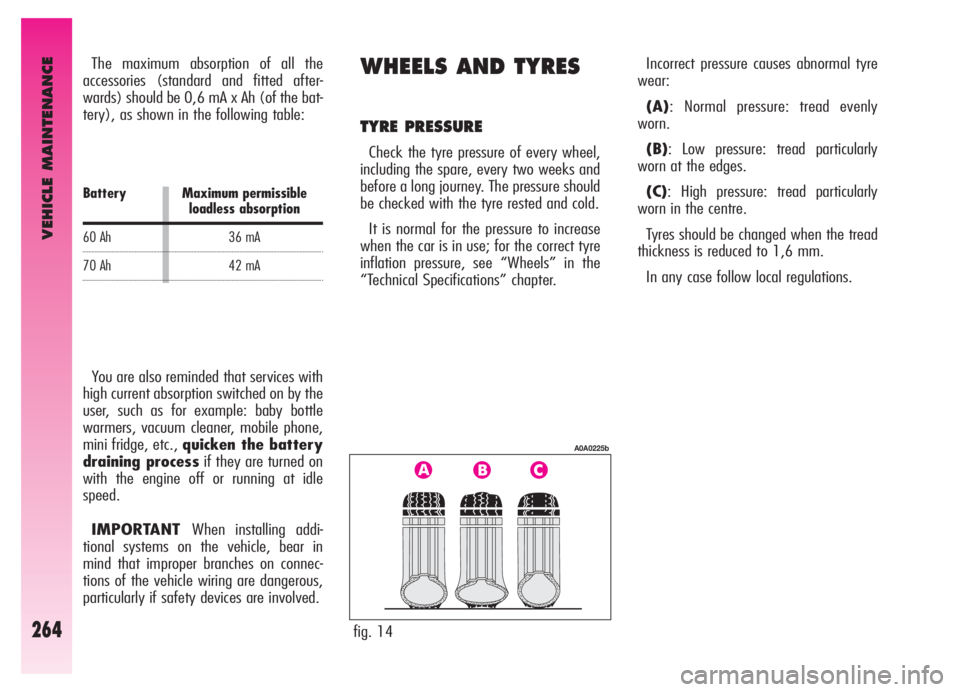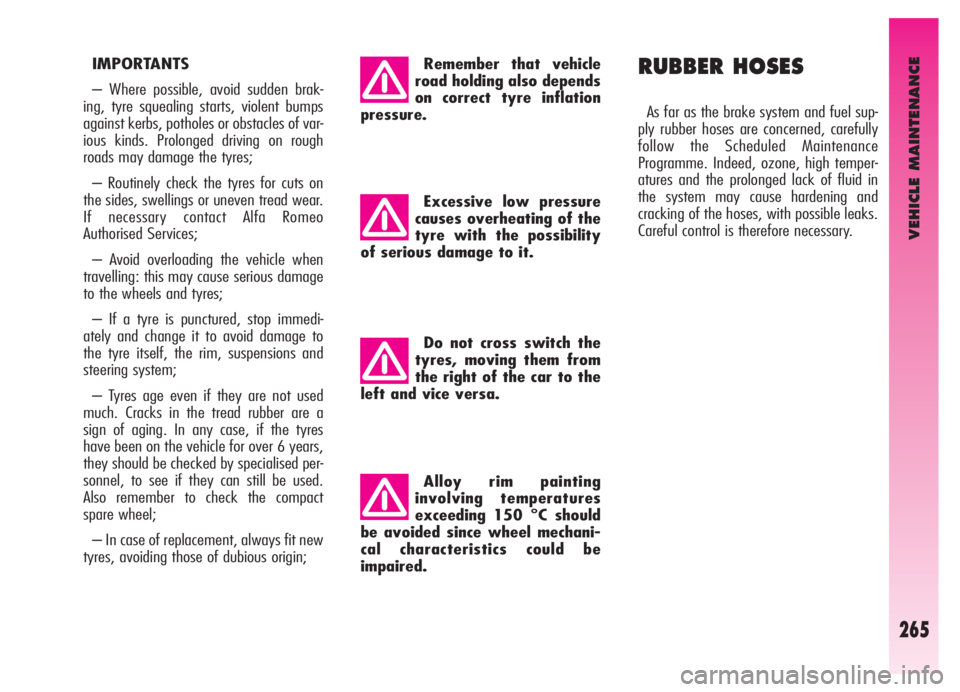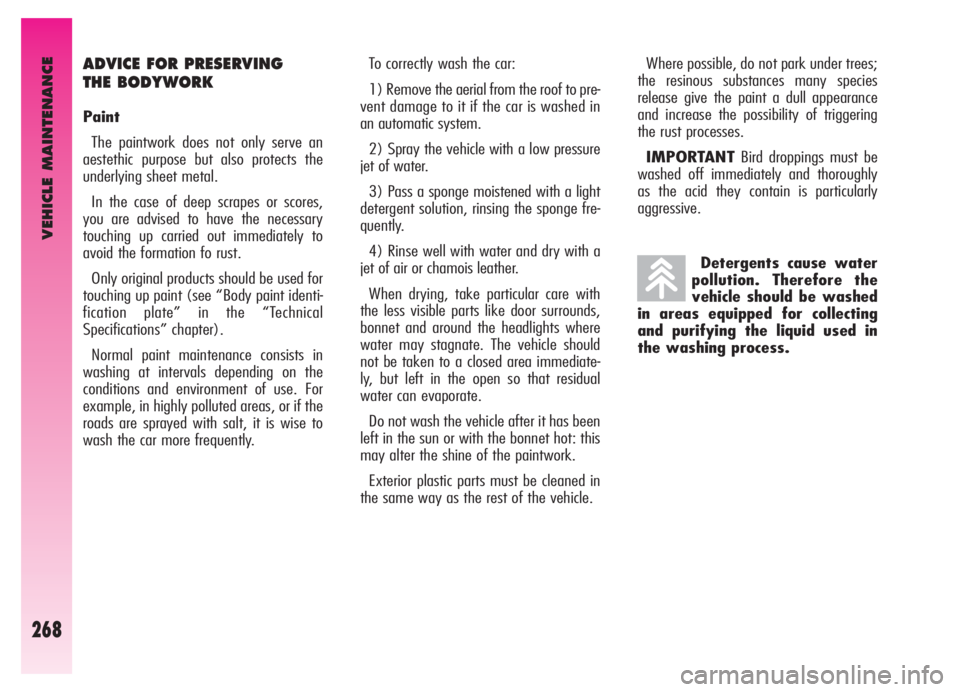Alfa Romeo GT 2005 Owner handbook (in English)
Manufacturer: ALFA ROMEO, Model Year: 2005, Model line: GT, Model: Alfa Romeo GT 2005Pages: 307, PDF Size: 6.05 MB
Page 261 of 307

VEHICLE MAINTENANCE
259
Do not travel with the
windscreen washer reser-
voir empty: the action of
the windscreen washer is funda-
mental for improving vision.
To avoid damaging the
pump motor, do not use the
windscreen/rearscreen
washers when the reservoir is
empty.
Some commercial addi-
tives for windscreen wash-
ers are inflammable. The
engine compartment contains hot
components which may set it on
fire.
IMPORTANTBrake and hydraulic
clutch fluid is hygroscopic (i.e. it absorbs
moisture). For this reason, if the car is
mainly used in areas with a high degree of
atmospheric humidity, the fluid should be
replaced at more frequent intervals than
specified in the Scheduled Maintenance
Programme.
WINDSCREEN/REARSCREEN
HEADLIGHT WASHER FLUID
(fig. 11)
Open the cap (A) and check the level in
the reservoir.
If necessary top up using a mixture of
water and TUTELA PROFESSIONAL
SC 35fluid as follows:
– 30% of TUTELA PROFESSIONAL
SC 35and 70% water in summer;
– 50% of TUTELA PROFESSIONAL
SC 35and 50% water in winter;
– in the case of temperatures below -
20°C use TUTELA PROFESSIONAL
SC 35fluid neat. Brake and clutch fluid is
poisonous and highly cor-
rosive. In the event of
accidental contact, wash the
parts concerned immediately with
neutral soap and water, then
rinse thoroughly. See a doctor at
once if the fluid is swallowed.
Theπsymbol on the
container indicates syn-
thetic brake fluid, distin-
guishing it from the mineral kind.
Using mineral fluids irreversibly
damages the special braking sys-
tem rubber seals.
fig. 11
A0A0242b
Page 262 of 307

VEHICLE MAINTENANCE
260
DIESEL FUEL FILTER
(JTD16Vversions)
DRAINING CONDENSATION
WATER
The presence of water in
the supply circuit may
cause serious damage to
the entire injection system and
cause irregular running of the
engine. If the
cwarning light
turns on together with the mes-
sage on the reconfigurable multi-
function display, contact Alfa
Romeo Authorised Services as
soon as possible to have the sys-
tem relieved.
AIR CLEANER
The air cleaner is connected to the tem-
perature and air flow sensors which send
to the control unit the electric signals
needed for correct operation of the injec-
tion and ignition system.
It must therefore always be in perfect
conditions, to ensure correct operation of
the engine, low consumption and exhaust
emission levels.
If the operations con-
cerning cleaner replace-
ment described below are
not carried out correctly and with
the due precautions, they may
compromise the travelling safety
of the vehicle. You are recom-
mended to have this operation
carried out by Alfa Romeo
Authorised Services.
If the car is habitually
used in dusty areas, the
cleaner should be replaced
at shorter intervals than those
specified in the Programmed
Maintenance Schedule.
Any attempt to clean the
cleaner may damage it,
leading to serious engine
damage.
Page 263 of 307

VEHICLE MAINTENANCE
261
BATTERY
The battery is of the “Limited
Maintenance” type and is fitted with an
optical indicator (A-fig. 12) for check-
ing the electrolyte level and charge.
Under normal conditions of use the elec-
trolyte does not need topping up with dis-
tilled water. To make sure that it is in effi-
cient conditions, at routine intervals check
the indicator on the battery cover which
should be dark in colour with a green cen-
tral area.
If the indicator is a bright light colour, or
dark without the green central area, con-
tact Alfa Romeo Authorised Services.
fig. 12
A0A0224b
Batteries contain harmful
substances for the envi-
ronment. To change the
battery we advise contacting Alfa
Romeo Authorised Services who
are equipped for disposal respect-
ing nature and the law.
The incorrect installation
of electric accessories
may cause serious dam-
age to the vehicle. If, after buy-
ing the car, you wish to install
accessories (alarm, radio,
radiotelephone, etc.) contact Alfa
Romeo Authorised Services who
will be able to suggest the most
suitable devices and above all
advise about the need to use a
more powerful battery.
If the car is to remain
inactive for a long time in
very cold conditions,
remove the battery and take it to
a warm place, otherwise it may
freeze.
POLLEN FILTER
Have the dust/pollen filter checked once
a year by Alfa Romeo Authorised Services,
preferably at the onset of summer.
If the car is mainly used in dusty or heav-
ily polluted areas, the filter should be
changed at more frequent intervals than
specified in the Scheduled Maintenance
Programme.
IMPORTANTThe failure to replace
the pollen filter can considerably reduce
the effectiveness of the climate control
system.
When working on the
battery or near to it,
always protect the eyes
with goggles.
The liquid contained in
the battery is poisonous
and corrosive. Avoid con-
tact with the skin or eyes. The
battery should be charged in a
well ventilated place away from
naked flames or possible sources
of sparks: danger of explosion
and fire.
Page 264 of 307

VEHICLE MAINTENANCE
262
– Turn on the charger.
– After charging, turn off the charger
before disconnecting it from the battery.
– Re-connect the battery negative termi-
nal (–).
Never attempt to charge
a frozen battery: it must
firstly be thawed, other-
wise it may burst. If freezing has
occurred, the battery should be
checked before charging by spe-
cialised personnel, to make sure
that the internal elements are not
damaged and that the body is not
cracked, with the risk of leaking
poisonous and corrosive acid.CHARGING THE BATTERY
IMPORTANTThe battery charging
procedure is described only for information
purposes. This operation should be carried
out by Alfa Romeo Authorised Services.
Charging should be slow at a low amp
rating for 24 hours. Charging for a longer
time may damage the battery.
Charge the battery as follows:
– Disconnect the battery negative termi-
nal (–).
– Connect the charger cables to the bat-
tery terminal ensuring that the bias is cor-
rect.
CHECKING THE CHARGE
The battery charge may be checked sat-
isfactorily using the indicator, and acting
according to the colour the indicator
shows.
Refer to the table below or to the label
(fig. 13) on the battery itself.Working with a low fluid
level may damage the
battery irreversibly, even
causing it to burst.
Brilliantwhite colour
Dark colour
without green
area in the centre
Dark colour with green
area in the centre
Top up the electrolyte
Low charge level
Sufficient electrolyte level and chargeContact Alfa Romeo
Authorised Services
Charge the battery
(you are advised to contact
Alfa Romeo Authorised Services)
No action
fig. 13
A0A0393b
Page 265 of 307

VEHICLE MAINTENANCE
263
2.close the driver's window completely
keepingthe button pressedfor at
least 3 seconds after window closing (win-
dow upper stop);
3.repeat the same procedure (point 1
and 2) also for the front passenger's win-
dow;
4.check for proper initialisation by oper-
ating the windows automatically.
USEFUL HINTS TO EXTEND
THE LIFE OF YOUR BATTERY
To avoid rapidly draining the battery and
ensure that it continues to work correctly,
the following should be noted:
– The terminals must always be firmly
tightened.
– Within reason, avoid using electrical de-
vices for a long time when the engine is
switched off (radio, hazard warning lights,
parking lights, etc.). IMPORTANTIf the battery is kept
with a charge of below 50% it is damaged
by sulphation, its starting capability is
reduced and it is also more subject to the
possibility of freezing (this may occur
already at -10 °C). In the event of a pro-
longed inactivity, refer to the paragraph
“Vehicle inactivity”, in the chapter
“Correct use of the car”.
CHANGING THE BATTERY
When changing the battery it should be
replaced with another original one with
the same characteristics. If it is replaced
by a battery with different characteristics,
the maintenance intervals given in the
Scheduled Maintenance Programme in
this chapter are no longer valid and for
maintenance it will be necessary to follow
the battery Manufacturer’s instructions.
IMPORTANTAfter control unit power
disconnection (battery replacement or dis-
connection and replacement of power win-
dow control unit protection fuses), the
power window automatism shall be
restored.
Proceed as follows with doors closed:
1.open the driver's window completely
keepingthe button pressedfor at
least 3 seconds after window opening
(window lower stop);– When the vehicle is parked in a garage,
ensure that the doors, bonnet, boot and in-
ner lids are closed properly so that the lights
do not stay on permanently.
– Before carrying out any work on the
electric system, disconnect the negative ca-
ble from the battery.
– If after buying the car, you wish to in-
stall electric accessories which require a per-
manent electric supply (alarm, voice feature,
radionavigator with satellite antitheft func-
tion etc.) or accessories that burden the elec-
tric system, contact Alfa Romeo Authorised
Services whose qualified personnel, in ad-
dition to suggesting the most suitable de-
vices belonging to Lineaccessori Alfa Romeo,
will evaluate the overall electric absorption,
checking whether the vehicle’s electric sys-
tem is capable of withstanding the load re-
quired, or whether it should be integrated
with a more powerful battery. In fact, as
some of these devices continue absorbing
energy even when the ignition key is off (car
stationary, engine off), they gradually drain
the battery.
Page 266 of 307

VEHICLE MAINTENANCE
264
Incorrect pressure causes abnormal tyre
wear:
(A): Normal pressure: tread evenly
worn.
(B): Low pressure: tread particularly
worn at the edges.
(C): High pressure: tread particularly
worn in the centre.
Tyres should be changed when the tread
thickness is reduced to 1,6 mm.
In any case follow local regulations.
You are also reminded that services with
high current absorption switched on by the
user, such as for example: baby bottle
warmers, vacuum cleaner, mobile phone,
mini fridge, etc., quicken the battery
draining processif they are turned on
with the engine off or running at idle
speed.
IMPORTANT When installing addi-
tional systems on the vehicle, bear in
mind that improper branches on connec-
tions of the vehicle wiring are dangerous,
particularly if safety devices are involved.
WHEELS AND TYRES
TYRE PRESSURE
Check the tyre pressure of every wheel,
including the spare, every two weeks and
before a long journey. The pressure should
be checked with the tyre rested and cold.
It is normal for the pressure to increase
when the car is in use; for the correct tyre
inflation pressure, see “Wheels” in the
“Technical Specifications” chapter.
Battery
60 Ah
70 AhMaximum permissible
loadless absorption
36 mA
42 mA
The maximum absorption of all the
accessories (standard and fitted after-
wards) should be 0,6 mA x Ah (of the bat-
tery), as shown in the following table:
fig. 14
A0A0225b
Page 267 of 307

VEHICLE MAINTENANCE
265
Alloy rim painting
involving temperatures
exceeding 150 °C should
be avoided since wheel mechani-
cal characteristics could be
impaired.Do not cross switch the
tyres, moving them from
the right of the car to the
left and vice versa.Excessive low pressure
causes overheating of the
tyre with the possibility
of serious damage to it.Remember that vehicle
road holding also depends
on correct tyre inflation
pressure.
RUBBER HOSES
As far as the brake system and fuel sup-
ply rubber hoses are concerned, carefully
follow the Scheduled Maintenance
Programme. Indeed, ozone, high temper-
atures and the prolonged lack of fluid in
the system may cause hardening and
cracking of the hoses, with possible leaks.
Careful control is therefore necessary. IMPORTANTS
– Where possible, avoid sudden brak-
ing, tyre squealing starts, violent bumps
against kerbs, potholes or obstacles of var-
ious kinds. Prolonged driving on rough
roads may damage the tyres;
– Routinely check the tyres for cuts on
the sides, swellings or uneven tread wear.
If necessary contact Alfa Romeo
Authorised Services;
– Avoid overloading the vehicle when
travelling: this may cause serious damage
to the wheels and tyres;
– If a tyre is punctured, stop immedi-
ately and change it to avoid damage to
the tyre itself, the rim, suspensions and
steering system;
– Tyres age even if they are not used
much. Cracks in the tread rubber are a
sign of aging. In any case, if the tyres
have been on the vehicle for over 6 years,
they should be checked by specialised per-
sonnel, to see if they can still be used.
Also remember to check the compact
spare wheel;
– In case of replacement, always fit new
tyres, avoiding those of dubious origin;
Page 268 of 307

VEHICLE MAINTENANCE
266
SPRAY JETS (fig.16)
If the jet of fluid is inadequate, firstly
check that there is fluid in the reservoir:
see “Checking levels” in this chapter.
Then check that the nozzle holes are not
clogged, if necessary use a needle.
If necessary, direct the jet of fluid work-
ing on the adjustment screw. Changing the windscreen wiper
blade(fig. 15)
Instructions for removing the
windscreen wiper blade
Proceed as follows:
– raise the windscreen wiper arm (A);
– turn blade (B) 90° around pin (C),
set at the end of the arm;
– remove the blade from pin (C).
Instructions for refitting the
windscreen wiper blade
To refit the blade proceed as follows:
– fit pin (C) into the hole located at the
middle of the blade (B);
– place the arm with the blade on the
windscreen.
Driving with worn wiper
blades is a serious haz-
ard, because visibility is
reduced in bad weather.WINDSCREEN/REARS
CREEN WIPERS
BLADES
Periodically clean the rubber part using
special products; TUTELA PROFES-
SIONAL SC 35is recommended.
If the rubber blades are bent or worn
they should be replaced. In any case they
should be changed once a year.
A few simple notions can reduce the pos-
sibility of damage to the blades:
– If the temperature falls below zero
make sure that ice has not frozen the rub-
ber against the glass. If necessary, thaw
using an antifreeze product.
– Remove any snow from the glass: in
addition to protecting the blades, this pre-
vents effort on the motor and overheat-
ing.
– Do not operate the windscreen and
rearscreen wipers on dry glass.
fig. 16
A0A0696b
fig. 15
A0A0728b
Page 269 of 307

VEHICLE MAINTENANCE
267
HEADLIGHT WASHERS
(fig.17)
Regularly check that the spray jets are
intact and clean.
If it is necessary to direct the jet, contact
an Alfa Romeo Authorised Service
BODYWORK
PROTECTION FROM
ATMOSPHERIC AGENTS
The main causes of corrosion are:
– atmospheric pollution
– salty air and humidity (coastal areas,
or hot humid climates)
– seasonal environment conditions.
Not to be underestimated is also the
abrasive action of wind-borne atmospheric
dust and sand and mud and gravel raised
by other vehicles.
On your car Alfa Romeo has implement-
ed the best manufacturing technologies to
effectively protect the bodywork against
corrosion.
fig. 17
A0A0704b
These include:
– Painting products and systems which
give the vehicle particular resistance to
corrosion and abrasion.
– Use of galvanised (or pretreated)
steel sheets, with high resistance to corro-
sion.
– Spraying of the underbody, engine
compartment, wheel arches and other
parts with highly protective wax products.
– Spraying of plastic parts, with a pro-
tective function, in the more exposed
points: underdoor, inner wheel arch lin-
ings, etc.
– Use of “open” boxed sections to pre-
vent condensation and pockets of mois-
ture from triggering rust inside.
VEHICLE EXTERIOR AND
UNDERBODY WARRANTY
Alfa GTis guaranteed against perfo-
ration due to rust of any original element
of the structure or body. For the general
terms of this warranty, refer to the
Warrantly Booklet.
Page 270 of 307

VEHICLE MAINTENANCE
268
Detergents cause water
pollution. Therefore the
vehicle should be washed
in areas equipped for collecting
and purifying the liquid used in
the washing process.Where possible, do not park under trees;
the resinous substances many species
release give the paint a dull appearance
and increase the possibility of triggering
the rust processes.
IMPORTANTBird droppings must be
washed off immediately and thoroughly
as the acid they contain is particularly
aggressive.
To correctly wash the car:
1) Remove the aerial from the roof to pre-
vent damage to it if the car is washed in
an automatic system.
2) Spray the vehicle with a low pressure
jet of water.
3) Pass a sponge moistened with a light
detergent solution, rinsing the sponge fre-
quently.
4) Rinse well with water and dry with a
jet of air or chamois leather.
When drying, take particular care with
the less visible parts like door surrounds,
bonnet and around the headlights where
water may stagnate. The vehicle should
not be taken to a closed area immediate-
ly, but left in the open so that residual
water can evaporate.
Do not wash the vehicle after it has been
left in the sun or with the bonnet hot: this
may alter the shine of the paintwork.
Exterior plastic parts must be cleaned in
the same way as the rest of the vehicle. ADVICE FOR PRESERVING
THE BODYWORK
Paint
The paintwork does not only serve an
aestethic purpose but also protects the
underlying sheet metal.
In the case of deep scrapes or scores,
you are advised to have the necessary
touching up carried out immediately to
avoid the formation fo rust.
Only original products should be used for
touching up paint (see “Body paint identi-
fication plate” in the “Technical
Specifications” chapter).
Normal paint maintenance consists in
washing at intervals depending on the
conditions and environment of use. For
example, in highly polluted areas, or if the
roads are sprayed with salt, it is wise to
wash the car more frequently.